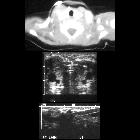sternocleidomastoid muscle


A
cross-section diagram of the human neck at the level of C6 showing the fascia compartments, muscles, organs, bone, and major arteries, veins, and nerves.
The sternocleidomastoid muscle (also known as sternomastoid) is found in the neck. It has two heads that meld to form one insertion. Sternocleidomastoid muscle, along with the trapezius muscle, is invested by the superficial layer of the deep cervical fascia, which splits around it. Sternocleidomastoid muscle divides the neck into anatomical anterior and posterior triangles.
Summary
- origin: manubrium, medial clavicle
- insertion: mastoid process, superior nuchal line
- innervation: accessory nerve (CN XI)
- action: lateral flexion, flexion and rotation of the head on the neck
Gross anatomy
Origin
- sternal head (round and tendinous): upper part of anterior surface of manubrium of sternum
- clavicular head (thin and broader fleshy): upper surface of medial third of clavicle
Course
- sternal head passes over the sternoclavicular joint and joins the clavicular head halfway up the neck
- common muscle belly then courses posterolaterally to its insertion
Insertion
- mastoid process of temporal bone
- lateral half of the superior nuchal line of the occipital bone
Relations
- upper half
- posteriorly: cervical plexus, which emerges from behind the lateral border of sternocleidomastoid muscle with some branches (lesser occipital, greater auricular and transverse cervical nerves) coursing anteriorly
- anteriorly: platysma muscle, external jugular vein
- lower half
- posteriorly: anterior scalene muscle, common carotid artery, internal jugular vein, carotid sheath
- anteriorly: platysma
Arterial supply
- superior thyroid and occipital arteries (both branches of the external carotid artery)
Innervation
- spinal part (C2, C3) of the accessory nerve (cranial nerve XI)
- the nerve descends and enters the muscle from its deep surface
Action
- when acting unilaterally: lateral flexion of neck to same side, rotates head to opposite side
- when acting bilaterally: flexes neck, draws head ventrally and elevates chin, draws sternum superiorly in deep inspiration
Variant anatomy
- absent mastoid insertion (occipital insertion only)
- absent clavicular or sternal head
- fusion with trapezius muscle
- additional clavicular head
- separate muscle bellies for sternomastoid and cleidomastoid
- separate muscle bellies for cleido-occipital and sternocleidomastoid
- doubles or quadrupled unilaterally or bilaterally
- absent unilaterally or bilaterally
Related pathology
Siehe auch:
und weiter:

 Assoziationen und Differentialdiagnosen zu Musculus sternocleidomastoideus:
Assoziationen und Differentialdiagnosen zu Musculus sternocleidomastoideus:

